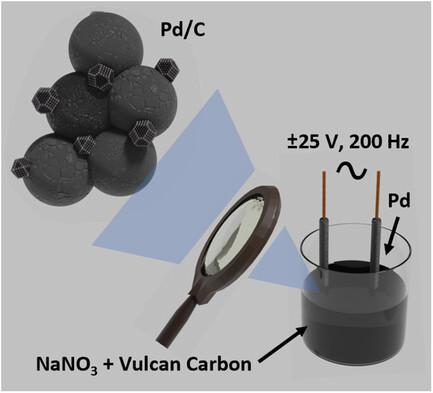Top-down Surfactant-Free Synthesis of Supported Palladium-Nanostructured Catalysts
IF 11.1
Q1 MATERIALS SCIENCE, MULTIDISCIPLINARY
引用次数: 0
Abstract
Nanostructured palladium (Pd) is a universal catalyst that is widely used in applications ranging from catalytic converters of combustion engine cars to hydrogenation catalysts in industrial processes. Standard protocols for synthesizing such nanoparticles (NPs) typically use bottom-up approaches. They utilize special and often expensive physical techniques or wet-chemical methods requiring organic surfactants. These surfactants should often be removed before catalytic applications. In this article, the synthesis of Pd NPs immobilized on carbon support by electrochemical erosion without using any surfactants or toxic materials is reported. The Pd NPs synthesis essentially relies on a Pd bulk pretreatment, which causes material embrittlement and allows the erosion process to evolve more efficiently, producing homogeneously distributed NPs on the support. Moreover, the synthesized catalyst is tested for hydrogen evolution reaction. The activity evaluations identify optimal synthesis parameters related to the erosion procedure. The electrocatalytic properties of the Pd NPs produced with sizes down to 6.4 ± 2.9 nm are compared with a commercially available Pd/C catalyst. The synthesized catalyst outperforms the commercial catalyst within all properties, like specific surface area, geometric activity, mass activity, specific activity, and durability.

自上而下无表面活性剂合成支撑钯纳米结构催化剂
纳米结构钯(Pd)是一种通用催化剂,广泛应用于从内燃机汽车催化转换器到工业过程中的加氢催化剂等领域。合成这种纳米颗粒(NPs)的标准方案通常采用自下而上的方法。它们利用特殊且通常昂贵的物理技术或需要有机表面活性剂的湿化学方法。这些表面活性剂通常需要在催化应用前去除。本文报道了在不使用任何表面活性剂或有毒材料的情况下,通过电化学侵蚀合成固定在碳支持物上的 Pd NPs。Pd NPs 的合成主要依赖于 Pd 块体预处理,这种预处理会导致材料脆化,并使侵蚀过程更有效地发展,从而在载体上产生均匀分布的 NPs。此外,还对合成的催化剂进行了氢进化反应测试。活性评估确定了与侵蚀过程有关的最佳合成参数。生成的 Pd NPs 尺寸小至 6.4 ± 2.9 nm,其电催化特性与市售的 Pd/C 催化剂进行了比较。合成催化剂在比表面积、几何活性、质量活性、比活性和耐久性等所有特性方面都优于市售催化剂。
本文章由计算机程序翻译,如有差异,请以英文原文为准。
求助全文
约1分钟内获得全文
求助全文
来源期刊
CiteScore
14.00
自引率
2.40%
发文量
0
期刊介绍:
Small Science is a premium multidisciplinary open access journal dedicated to publishing impactful research from all areas of nanoscience and nanotechnology. It features interdisciplinary original research and focused review articles on relevant topics. The journal covers design, characterization, mechanism, technology, and application of micro-/nanoscale structures and systems in various fields including physics, chemistry, materials science, engineering, environmental science, life science, biology, and medicine. It welcomes innovative interdisciplinary research and its readership includes professionals from academia and industry in fields such as chemistry, physics, materials science, biology, engineering, and environmental and analytical science. Small Science is indexed and abstracted in CAS, DOAJ, Clarivate Analytics, ProQuest Central, Publicly Available Content Database, Science Database, SCOPUS, and Web of Science.

 求助内容:
求助内容: 应助结果提醒方式:
应助结果提醒方式:


